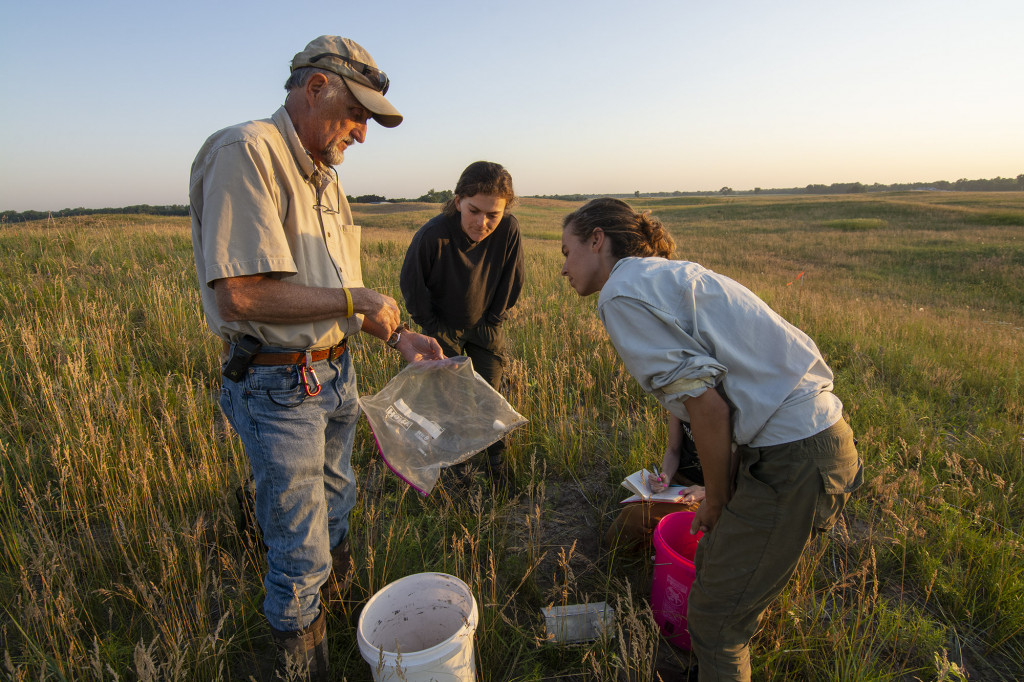
By Renae Blum
At first sight, a plains pocket mouse makes a lasting impression.
There’s only one word for it: cute. It’s tiny and delicate-looking, with small ears and fur-lined cheek pouches. Retired wildlife ecologist Mike Schrad can identify one in seconds, as he does on this cool October morning, striding through a restored prairie near Wood River, Nebraska.
He lifts one from a live trap baited with oatmeal and birdseed, and hands it me to warm in my palm while he takes notes. My hand cups easily around it.
This creature is one of five small mammals Schrad will find and release out of 80 traps on this particular morning (better than average numbers, he tells me). The plains pocket mouse is of particular interest, though. The eastern subspecies is an at-risk species that relies on prairie habitat, and Schrad is helping document its presence in Nebraska, along with other small mammals.
His work could inform future management practices statewide and help conservationists understand what kind of habitat Nebraska’s small mammals need to thrive. Schrad also is finding plains pocket mice in places they’ve never been documented, adding to our understanding of this elusive species.
But Schrad, age 71, isn’t your typical researcher. While he’s doing professional-level work for several organizations in the state, it’s all for free, on his own time.
It’s fun for him, Schrad said, and he enjoys being outdoors. But that’s not his only motivation.
“When I retired, I wanted to get back to field work,” Schrad said. “I was looking for an organization I could volunteer for, and that’s when I found the Master Naturalists.”
He’s referring to the Nebraska Master Naturalist Program, which offers training and volunteer opportunities to anyone interested in the natural world. As part of his training, Schrad sat in on a presentation about Nebraska Game and Parks’ Natural Legacy Project, a blueprint for conservation of Nebraska’s at-risk species.
Kristal Stoner, the program manager at the time, told the group that they were in need of volunteers willing to help them find and record these species. “That kind of rang a bell with me,” Schrad said.
He approached Stoner, and they realized his skills would be a great match for one of the program’s needs: monitoring Tier 1 species of small mammals, or those identified as species of greatest conservation need — including the plains pocket mouse.
Currently, Schrad traps three times per year, in spring, summer and fall, typically for four nights each season. He arrives at first light the following morning to inspect the traps and record data. Then, Schrad uses those numbers to calculate results, including species diversity, species richness and relative abundance.
“And then we use those numbers to see if it answers our questions,” Schrad said. “For example, the management question — are there differences in these numbers when you hay a pasture, or burn it, or manage it strictly by grazing.”
He has probably saved Nebraska Game and Parks tens of thousands of dollars for surveys, said Melissa Panella, Game and Parks’ wildlife diversity program manager and program manager for the Natural Legacy Project. Game and Parks has limited funds to pay for surveys and monitoring, so Schrad’s work fills an important gap, she said.
Seven years in, Schrad has volunteered with multiple groups, including Pheasants Forever, the University of Nebraska at Omaha and the Nature Conservancy, and he’s placed about 5,000 traps.
“He’s very generous with his time,” said Chris Helzer, the director of science at the Nature Conservancy, who has worked with Schrad since the beginning. Their particular project looks at how small mammal populations differ between two areas, a 60-acre remnant of virgin prairie and a 100-acre tract of restored prairie next to it.
So far, the plains pocket mouse seems to prefer the virgin prairie, but other small mammals appear to like the restored prairie better. To Helzer, it’s further evidence that through prairie restoration, we can expand isolated patches of virgin prairie into larger areas benefiting a diverse range of species.
“Our property is pretty small and insignificant by itself,” Helzer said. “But we’ve shown, I think, that the potential is there for de-fragmenting prairies anywhere we want to work on this in Nebraska.”
Both he and Panella see Schrad as a unique volunteer, someone with subject matter expertise who approached them first, looking to help with no expectation of pay. Someone like this is a rare and incredibly helpful find: Panella looks back to a recent time that Game and Parks needed help documenting the state’s river otter population, before removing river otters from Nebraska’s threatened species list.
“We didn’t have a volunteer; we ended up bringing on a graduate student for a two-year project,” she said.
That’s a typical length of time for surveys like these, but Schrad is committed for the long term. He envisions another 10 years of documenting the plains pocket mouse and at least five more years with the Nature Conservancy.
“Anytime we have an opportunity to do a long-term monitoring project, that’s a huge benefit,” Panella said. “That’s much more informative than just that snapshot in time.”
For Schrad, his small mammal work has meaning beyond personal enjoyment and the valuable data it’s yielding. It’s something he once never imagined he could do.
Sixteen years ago, Schrad was diagnosed with stage four colon cancer, with a dim prognosis. Today, for reasons he can’t explain, he’s cancer-free and enjoying retirement to the fullest. He has a message for other cancer patients: Never give up.
“They should always have hope,” he said. “And if it’s not hope to survive for 50 years, hope that you can make it to somebody’s next birthday, or whatever it might be. Just keep plugging away.”
Which he plans to continue doing for as long as possible.
